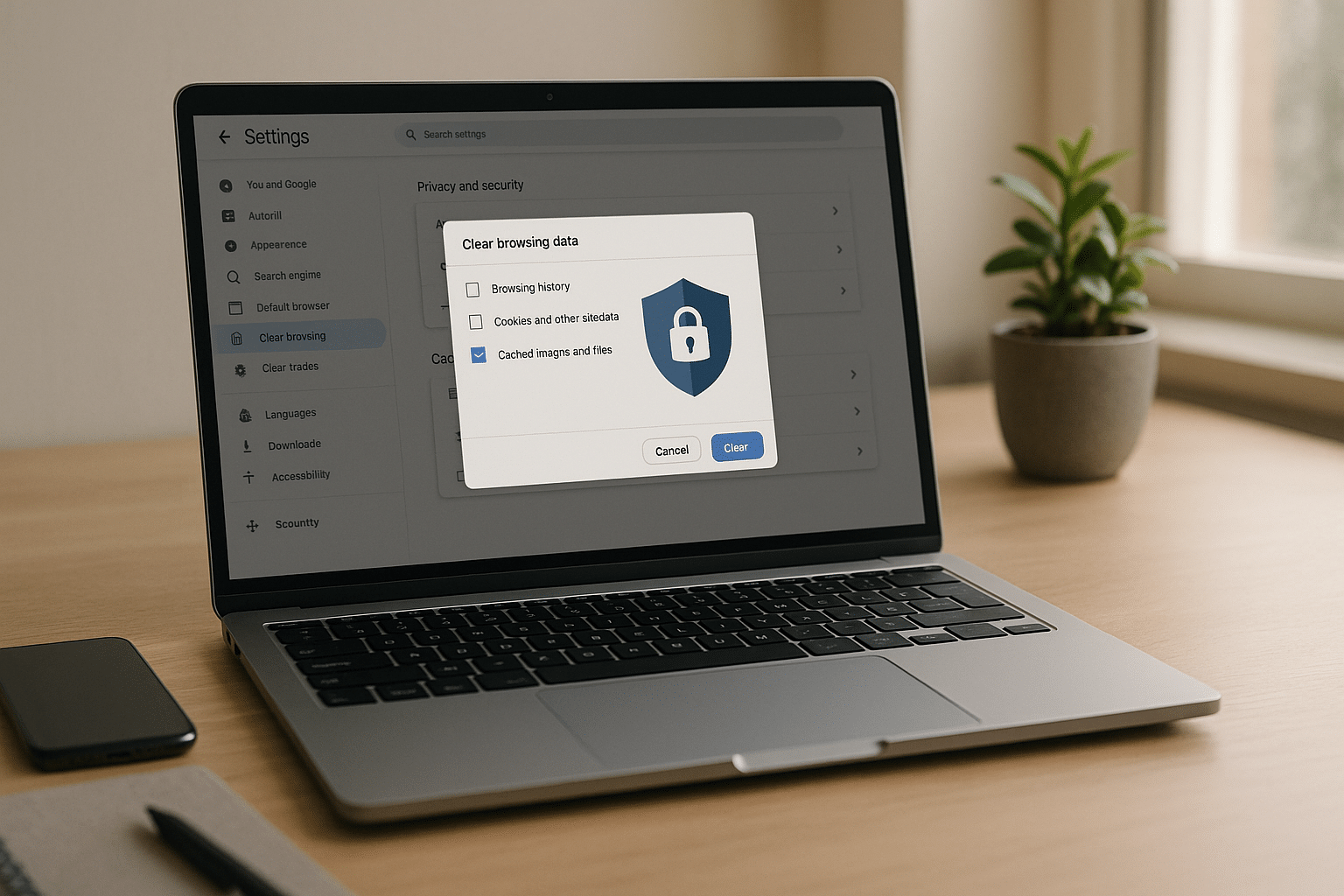Even something as innocuous as a browser cache can become a hotbed for malicious activity if not handled correctly. 🕵️♀️ This is why understanding how to effectively clear your browser cache isn’t just a technical maintenance task, but a vital part of your digital safety arsenal.
But first, let’s clarify some terms. What is a browser cache? Simply put, it’s a temporary storage location in your device for web documents such as HTML pages and images. This allows for quicker access to frequently visited sites. Sounds harmless, right? But don’t be fooled. Under certain conditions, this stored data can be exploited by cybercriminals, revealing sensitive information and compromising your online security. 💻🔒
Why is clearing your browser cache important?
Caches, while beneficial for speeding up browsing, have the potential to store sensitive data such as passwords, credit card information, or personal addresses. These data, if fallen into the wrong hands, can lead to identity theft, unauthorized transactions, and various other security breaches. In this article, we’ll delve into the importance of regularly clearing your browser cache to protect your online presence, how to do it on different browsers, and additional steps to fortify your digital security. 🛡️🌐
What will this article cover?
This comprehensive guide will illuminate the importance of a cleared browser cache in fortifying your online security. Here, we will cover:
- The role of browser cache in your digital life
- How cybercriminals can exploit unattended browser caches
- Step-by-step guide on how to clear your browser cache on various platforms (Google Chrome, Firefox, Safari, and Edge)
- Additional practices to enhance your overall online security
We promise to break down this technical topic into digestible, actionable steps. By the end of this article, you’ll have the know-how to clear your browser cache like a pro, boosting your online security and ensuring a safer browsing experience. 🚀🔒
Who will benefit from this article?
While this topic might seem inclined towards those with a background in IT or tech-savvy individuals, the truth is far from it. Every internet user, from online shoppers 🛍️, remote workers 💼, to social media enthusiasts 📱, stands to benefit from understanding and regularly clearing their browser cache. If you use the internet, this article is a must-read.
So, brace yourself as we embark on a journey to boost your security. Clearing your browser cache might not be the most glamorous part of your online activities, but it’s a crucial habit you need to cultivate for a safer online experience. Let’s get started. 💪🚀
🔒 Enhance Your Online Safety: The Importance of Clearing Browser Cache
The internet has become a vital part of our daily lives. Whether for work, socializing, or leisure, we’re spending more and more time online. As our digital footprint expands, so does the risk of cyber threats. One commonly overlooked aspect of online security is the browser cache. This cache, a component of your web browser, stores various pieces of information from websites you visit, such as images, scripts, and other types of data. While this function can help speed up your browsing experience, it can also pose potential security threats.
Regularly clearing your browser cache is an essential step to secure your online experience. This practice helps to prevent unwanted access to your sensitive information, protect against various cyber threats, and keep your computer running smoothly. In this article, we will delve deep into the intricacies of the browser cache, why it’s crucial to clear it routinely, and a step-by-step guide to doing so.
To kick things off, let’s take a closer look at what exactly a browser cache is and how it functions.
🕵️♀️ Unveiling the Browser Cache: What is it and How Does it Work?
A browser cache is a temporary storage location on your computer for files downloaded by your browser to display websites. Files that are cached locally include any documents that make up a website, such as HTML files, CSS style sheets, JavaScript scripts, as well as graphic images and other multimedia content.
When you revisit a website, the browser checks which content was updated in the meantime and only downloads updated files or what is not already stored in the cache. This reduces bandwidth usage and load times. However, while this makes your online experience more efficient, it can also store information that you may not want to keep, including private data or information from websites that you no longer visit.
Now that we’ve demystified what a browser cache is, let’s move onto why it’s important to clear it regularly.
🔓 Why Clearing Your Browser Cache Boosts Your Online Security
Think of your browser cache as a digital record of your online activity. It contains traces of every website you visit, every image you view, and every video you watch. This information can be a goldmine for cybercriminals. If they manage to infiltrate your cache, they can gather a wealth of information about your online habits, preferences, and even personal details. Clearing your browser cache makes it harder for these cybercriminals to access this information.
Clearing your cache also improves your overall online privacy. For instance, if you use a shared or public computer, the next user won’t be able to see what websites you visited or retrieve your login credentials.
Another benefit of clearing your browser cache is enhancing your browsing experience. Over time, your cache can become cluttered with outdated files from websites you no longer visit. This can slow down your browsing speed and cause websites to load incorrectly. By regularly clearing your cache, you can ensure that you’re always viewing the most up-to-date version of a website and keep your browser running smoothly.
🛠️ How to Clear Your Browser Cache: A Step-by-Step Guide
Clearing your browser cache is a straightforward process that varies slightly depending on the browser you’re using. In this section, we’ll provide step-by-step instructions for clearing your cache on some of the most popular browsers: Google Chrome, Mozilla Firefox, and Microsoft Edge.
Before we start, it’s important to note that clearing your cache will log you out of any websites you’re currently signed into and may cause some websites to load slightly slower on the first visit after clearing your cache. So, you might want to ensure you have any necessary login details handy before proceeding.
Now, let’s get started with the step-by-step guide.
🌐 Clearing Cache in Google Chrome
- Open Google Chrome and click on the three vertical dots in the top right corner of the browser.
- From the drop-down menu, navigate to “More tools” > “Clear browsing data”.
- In the pop-up window, select “Cached images and files”.
- Choose the time range for which you want to clear the cache. To clear the entire cache, select “All time”.
- Click “Clear data”.
🦊 Clearing Cache in Mozilla Firefox
- Open Mozilla Firefox and click on the menu button (three horizontal lines) in the top right corner of the browser.
- From the menu, select “Options”.
- In the Options tab, click on “Privacy & Security”.
- Scroll down to the “Cookies and Site Data” section and click “Clear Data”.
- In the pop-up window, check the box for “Cached Web Content” and click “Clear”.
🖥️ Clearing Cache in Microsoft Edge
- Open Microsoft Edge and click on the three horizontal dots in the top right corner of the browser.
- From the drop-down menu, select “Settings”.
- In the Settings menu, navigate to “Privacy, search, and services”.
- Under the “Clear browsing data” section, click “Choose what to clear”.
- In the pop-up window, check the box for “Cached images and files” and click “Clear”.
📹 Further Learning: Video Tutorials on Clearing Browser Cache
For those who prefer visual learning, there are numerous video tutorials available online that provide step-by-step instructions on how to clear your browser cache. Here are a few recommended ones:
- “How to Clear Cache in Google Chrome” – Britec09
- “Clear Cookies, Browsing History and Cache in Firefox” – SkillForge
- “How to Clear Cache and Cookies in Microsoft Edge” – MDTechVideos
These tutorials offer clear and concise instructions, making the process easy even for those who may not be technically inclined.
💪 Power Up Your Online Security: Keep Your Cache Clear
In the current digital age, online security is of utmost importance. Every step we take to protect our online presence, no matter how small, contributes to a safer online experience. Regularly clearing your browser cache is one such step. It’s a simple yet effective measure to protect your private data, enhance your online privacy, and maintain an efficient browsing experience.
Remember, your online security is in your hands. Stay vigilant, stay safe.

Conclusion
In wrapping up this in-depth exploration into the realm of Software Engineering, it’s imperative to recap on the salient points that have been extensively discussed. Reflecting on the journey we’ve taken, it becomes apparent that the vast landscape of software engineering is indeed as complex as it is fascinating. It’s a sector that is continuously evolving, with new methodologies, technologies, and practices being introduced at a rapid pace.
Our deep dive began with a detailed overview of software engineering, its history, and its significance in the modern world. We further delved into different software engineering methodologies like Waterfall, Agile, and DevOps, each with its unique approach and benefits. This exploration was supplemented by a careful analysis of the essential software engineering principles, ranging from modularity to encapsulation, and abstraction to inheritance.
One of the key takeaways from this exploration is the paramount importance of the right choice of methodology and adherence to principles in software development. 🧠👨💻 They’re the very backbone of creating robust, scalable, and maintainable software systems.
The role of software testing was another crucial point of discussion. The importance of rigorous testing cannot be overstated in the software development process, ensuring the reliability and functionality of the final product.🔎🐞
To further highlight the role of innovation in software engineering, we delved into the promising future trends like AI-driven development, Quantum computing, and Blockchain technology. These burgeoning technologies are already starting to shape the landscape of software engineering, opening up new possibilities and challenges.
The extensive exploration of such a vast subject as software engineering could not have been possible without the invaluable resources that served as references. You’re encouraged to delve deeper into these topics by accessing the numerous references provided throughout the article. ACM, IEEE Computer Society, and Journal of Systems and Software are among the resources that can provide you with a wealth of knowledge on these topics.
It’s my sincere hope that this article has offered valuable insights, sparked curiosity, and armed you with a wealth of knowledge about software engineering. 🧠💡
The world of software engineering is constantly evolving and is driven by continuous learning and innovation. As we journey together through this ever-changing landscape, I encourage you to share your thoughts, ideas, and experiences. Let’s keep the conversation going in the comment section. Your perspective could provide valuable insights and inspire others.
If you found this article helpful, feel free to share it with your colleagues and friends. 🌐👥 Knowledge, after all, is meant to be shared. And who knows? Your share could inspire someone else to embark on a journey into the captivating world of software engineering.
In conclusion, software engineering is a field that combines creativity with analytical thinking, logical reasoning with innovative ideation. As we continue to unravel its many facets, remember to keep learning, stay curious, and most importantly, enjoy the process. 🚀🌟
And finally, don’t forget to apply what you’ve learned. The knowledge gained is only as useful as its application. So, go ahead, apply these principles, experiment with these methodologies, and take your software engineering prowess to the next level. 🚀
Thank you for joining me in this journey through the world of software engineering. Until our next exploration, happy coding! 👋💻



